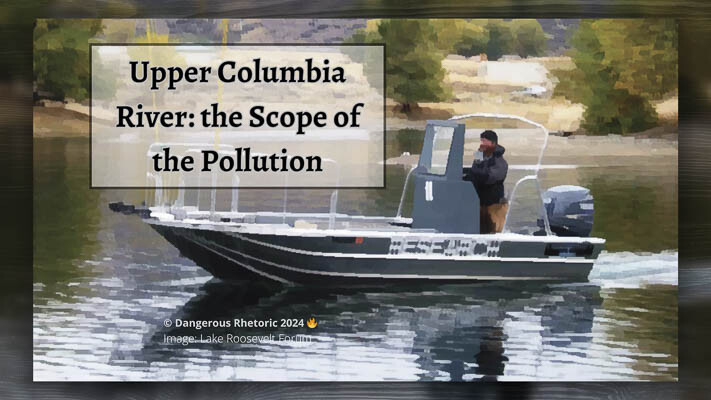
Nancy Churchill offers the third in a series of columns about the proposed EPA Superfund site on the upper Columbia River
Nancy Churchill
Dangerous Rhetoric
This is part three of a series of articles about the proposed EPA Superfund site on the upper Columbia River. In this article, we will discover the sources and types of pollution in Lake Roosevelt. We’ll also review the 2006 agreement between the U.S. Government and Teck American that has been in place for the last 18 years. Part two, “A Short History of Grand Coulee Dam and Lake Roosevelt,” is available at nancydchurchill.substack.com

Sources of pollution
There were two sources of pollution in the upper Columbia River. According to the EPA News Release, “The primary source of contamination at the site is the Teck Metals Ltd. smelting facility in Trail, British Columbia, approximately 10 river miles upstream of the international boundary. The former Le Roi smelter in Northport, Washington also contributed contamination.”
The northeastern corner of Washington has a rich mining history, with significant deposits of gold, silver, copper, lead, zinc and other minerals. The EPA states “Historic discharges of wastes and emissions from smelter operations have contaminated portions of the upper Columbia River. Decades of smelter processes and facility operations have caused releases of hazardous substances, granulated slag, liquid effluents, emissions, and accidental spills in and around the river.”
Unfortunately, the desirable ores are usually found in deposits that also include heavy metals and more dangerous minerals. “High levels of zinc, cadmium, and lead contamination have been found in upland soils,” and are a potential threat to the wildlife. These were from smokestack emissions and settled in an area on both sides of the river called the uplands.
“Residential properties where soil is contaminated with lead and arsenic may pose a health risk to current and future residents, especially young children…” Fortunately, as part of the Settlement Agreement discussed below, Teck American and the EPA have accomplished significant remediation of the soil in and around the town of Northport.
In addition to smokestack emissions, smelting and mining in Trail and Northport discharged slag directly into the river. “River sediments and a few riverbanks are contaminated with levels of slag and metals including lead, arsenic, zinc, cadmium, chromium, copper, and mercury that exceed Washington State Freshwater Sediment Management Standards.” Since it’s unknown how far downstream these heavy metals have spread, the EPA included the entire length of Lake Roosevelt from the border to Grand Coulee Dam in its initial studies.
The 2006 Settlement Agreement
According to the Lake Roosevelt Forum “In 2005, the Environmental Protection Agency (EPA) initiated the Upper Columbia River Remedial Investigation and Feasibility Study (RI/FS). Funded under a settlement agreement with Teck, its purpose is to establish the nature, extent and possible human and ecological risks of metals and other contaminants released into the environment.” The Settlement Agreement was signed in 2006.
“The Remedial Investigation establishes the nature and extent of contamination and includes findings from human health and ecological risk assessments. The Feasibility Study develops, screens, and evaluates cleanup actions to address risks identified in the river, lakes, or uplands.” From 2006 to today (eighteen years), Teck has been conducting the RI/FS and extensive remediation under the supervision of the EPA.
According to the company, “Teck has invested over $170 million in EPA’s study of the upper Columbia River, which is well advanced, and has included sampling of water, fish, beaches, sediments, soils, and plants. Based on these and other relevant data and studies, in 2021, EPA finalized its human health risk assessment. A companion baseline ecological risk assessment is well underway.”
In addition, Teck has made significant improvements in the Trail smelter, investing “over $1.7 billion to continuously advance the environmental and operational performance of the smelter. Today, the Trail smelter is a world-class facility supplying and recycling vital metals and critical minerals to Canada, the U.S. and world economies.”
Key findings of the Human Health Assessment.
The abundant game fish in Lake Roosevelt are safe to eat, subject to mild statewide and local-area advisories set by the Washington Department of Health. The lake is a robust recreational fishery, with over 1.5 million visitors every year. Surface water is safe for all manner of recreational activities. In fact, concentrations of metals are a fraction of allowed maximum contaminant levels for drinking water, though residents and visitors should not drink river water due to potential bacterial content. Only one beach has been closed, the remaining beaches are safe.
Additional studies have yet to be completed as part of the scope of work defined in the 2006 Agreement.
“The baseline ecological risk assessment, a companion to EPA’s human health risk assessment, is underway and is expected to be completed in 2024. These and other reports will be followed by a feasibility study to evaluate potential remedial actions. The studies will conclude with EPA’s selection of final remedial actions following which EPA will issue a final record of decision (ROD). At this time, it is anticipated that EPA will complete the ROD in 2028.” Since the studies agreed to and funded by the 2006 RI/FS have not yet been completed, is it too early to pull the trigger on a superfund listing? What scientific basis is being used if the studies are not complete?
Next Steps
In the next article in this series, we’re going to take a look at the Superfund rules, the specific reasons for the proposed Superfund listing, and the role of Governor Inslee in this process. We’ll also look at the potential action timeline if the listing is approved and what a listing would accomplish for Lake Roosevelt and the nearby communities. In future articles, we also will review the reactions of the local county governments, community members and the health departments. After that, we’ll cover the rules for making a comment.
We’re covering a large amount of background information with the purpose of helping you, the everyday citizen, have the knowledge and understanding you need to make a compelling comment on the proposal before the beginning of May. Well informed comments will be more impactful than simple oppose or approve comments. Armed with knowledge and information, you CAN influence the EPA.
Nancy Churchill is a writer and educator in rural eastern Washington State, and the state committeewoman for the Ferry County Republican Party. She may be reached at DangerousRhetoric@pm.me. The opinions expressed in Dangerous Rhetoric are her own. Dangerous Rhetoric is available on thinkspot, Rumble and Substack.
Also read:
- Opinion: Restore Election Confidence Initiative signature-gathering effort nears deadlineThe Restore Election Confidence (REC) Initiative is in its final stage of signature gathering, with a deadline set for May 25, 2024.
- Opinion: Would the passage of Initiative 2124 kill WA Cares?Elizabeth New (Hovde) believes it’s likely that if the state’s new, mandatory long-term-care program was made optional for Washington state workers many would flee, leaving it unable to pay its way in its current form.
- Opinion: Making sense of filing weekThe week of May 6 to 10 was filing week in Washington state.
- Opinion: For the love of mom, vote yes on I-2124Let’s Go Washington Press Secretary Hallie Balch offers support for Initiative 2124, the Opt Out of State-Run Long Term Care Coverage Act.
- POLL: Do you support Initiative 2124, which would make participation in WA Cares optional?Do you support Initiative 2124, which would make participation in WA Cares optional?










